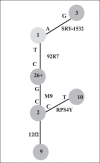Y-haplotypes and idiopathic male infertility in an Indian population
- PMID: 20407645
- PMCID: PMC2846564
- DOI: 10.4103/0971-6866.50865
Y-haplotypes and idiopathic male infertility in an Indian population
Abstract
Infertility being a multifactorial disorder, both genetic and environmental factors contribute to the etiology of infertile phenotype. Chromosomal anomalies and Y-microdeletion are the established genetic risk factors of male infertility. Y-haplotypes has been found as risk factor for male infertility in certain populations, though in certain others no association has been reported, suggesting a population-specific association of these variations with male infertility. In a case-control study, 165 azoo-/oligospermic patients and 200 controls were haplotyped for certain Y-haplogroups for a possible association with idiopathic male infertility in an Indian population. Analysed Y-haplogroups showed no association with infertile phenotype. Thus this genetic factor is not a risk for infertility in the studied Indian population but that does not rule out the possibility of any of them, to be a risk in other populations.
Keywords: Male infertility; Y-haplotypes; single nucleotide polymorphism.
Conflict of interest statement
Figures




References
-
- Krausz C, Quintana-Murci L, Rajpert-De Meyts E, Jorgensen N, Jobling MA, Rosser ZH, et al. Identification of a Y chromosome haplogroup associated with reduced sperm counts. Hum Mol Genet. 2001;10:1873–7. - PubMed
-
- Matzuk MM, Lamb DJ. Genetic dissection of mammalian fertility pathway. Nat Cell Biol Nat Med. 2002 Oct;4(Suppl):s41–9. - PubMed
-
- Johnson MD. Genetic risks of intracytoplasmic sperm injection in the treatment of male infertility: Recommendations for genetic counseling and screening. Fertil Steril. 1998;70:119–24. - PubMed
-
- McElreavey K, Krausz C, Bishop CE. The human Y-chromosome and male infertility. Results Probl Cell Differ. 2000;28:211–32. - PubMed
-
- Jobling MA, Tyler-Smith C. The human Y chromosome: An evolutionary marker comes of age. Nat Rev Genet. 2003;4:598–611. - PubMed
LinkOut - more resources
Full Text Sources

